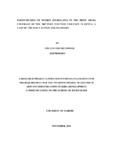| dc.description.abstract | This study seeks to investigate the role played by women journalists in the print media in Kenya in reporting the Post-Election violence of 2007 in Kenya, focusing on the Nation and the Standard newspapers. The overall objective of the study was to establish the extent of involvement of women journalists in reporting on the 2007 post-election violence. The study was based on the media coverage of the 2007/2008 post-election violence in Kenya. The specific objectives of the study were; to establish what aspects of the post-election violence that women journalists reported on in the print media, to find out the placement of news stories on the post-election violence written by women journalists and to find out what editors considered before assigning women journalists certain aspects of the post-election violence to cover. This study has employed a qualitative research approach. The study used primary data which was collected through content analysis of the Nation and Standard. It has also involved the use of semi structured interviews to collect data from the participants. Besides that, the study has used thematic analysis method as its analysis strategy. The study established that women journalists in the print media were highly sidelined during the coverage of the 2007/2008 post-election violence in Kenya. The study found out that out of the total 682 news stories on post-election violence that were written and published in the two leading newspapers, only 42 news stories or 6% were written by women journalists only. The study also reveals that women journalists during the post-election violence were mainly involved in reporting on humanitarian stories, followed by stories on peace building. In addition, the study found out that women journalists were highly sidelined when it came to reporting on the actual violence which included violent attacks and combat. Only 10% of the total number of news stories that were written by women journalists focused on the actual violence and combat of the post-election violence. On reporting on the actual violence, the study found, women journalists were mostly paired up with other male journalists. The study also established that news stories on post-election violence written by women journalists were not given great prominence when it came to their placement in the newspapers by page and size. There was no single news story written by a woman journalist that was published on page one as the lead story. The study concludes that women journalists in the print media were highly sidelined during the coverage of the 2007/2008 post-election violence in Kenya. It recommends that more and more women journalists should be involved and trained in reporting on the major aspects of conflict and the actual violence of conflict events so as to acquire skills, knowledge and experience in covering such news stories. The study further recommends that the local print media industry should increase the number of women journalists in their newsrooms to beef up their ratio, which can be during the coverage of violence-related situations. | en_US |

